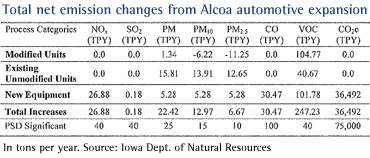Iowa Capital Dispatch
December 11, 2025
A federal judge has ruled federal animal-welfare inspectors can no longer conduct “courtesy visits” at dog-breeding operations while allowing violations to go unreported.
The ruling could... more

The heralded expansion of Alcoa's Davenport Works will add $300 million in new construction, an estimated 150 new jobs, and a significant increase in the facility's emission of volatile organic compounds (VOC's).
The increased emission of VOC's -- which lead to the formation of ground-level ozone -- is high enough to require the company to obtain a modification in its Prevention of Significant Deterioration (PSD) permit. The plant's air quality construction permit is under review by the Iowa Department of Natural Resources (IDNR), which will hold a public meeting on the issue at 6:30 p.m., Tuesday (1/17) at the Bettendorf Public Library.
The aluminum manufacturing facility at 4879 State Street currently emits an estimated 240 tons of VOC's each year, and that would be increased by an additional 247 tons with the planned expansion announced last September.
Ground-level ozone can be harmful to breathe and damages crops, trees and vegetation. It is created by chemical reactions between oxides of nitrogen (NOx) and volatile organic compounds (VOC) in the presence of sunlight. Emissions from industrial facilities and electric utilities, motor vehicle exhaust, gasoline vapors, and chemical solvents are some of the major sources of nitrogen oxide and VOC's, according to the U.S. Environmental Protection Agency.
The Iowa Economic Development Commission is providing $3 million in incentives for the plant expansion to accommodate the expected growth in aluminum use by the automotive industry.
Scott County currently is in "attainment" for ozone levels, but both ozone and particulate matter under 2.5 microns (PM 2.5) have been a concern of local governmental agencies.
The Bi-State Regional Commission's Air Quality Task Force - a coalition of private and public entities - was formed in 2009 to address air pollution in the region. The group has developed a voluntary emissions reduction program which includes recommended activities organizations can implement to reduce their emissions and help the region remain in attainment.
Falling out of attainment would lead to requirements to develop and implement ways to lower those emissions violating the federal limits. Such a non-attainment designation also could make it more difficult to attract new industry to the region.
In its public notice, the IDNR says the increased emissions of VOC's from the Alcoa expansion aren't expected to cause a violation of the National Ambient Air Quality Standards.
In addition to the VOC emissions, the plant expansion also means higher emissions of other pollutants: PM 2.5 (6.7 tons per year), nitrogen oxide (27 tons per year), carbon monoxide (30 tons per year), particulate matter less than 10 microns (13 tons per year), and carbon dioxide, also known as greenhouse gas emissions, (36,500 tons per year).
The public can make oral statements or submit written comments at the January 17 meeting. Written comments on the permit modification will be accepted by the IDNR until January 30.
CLICK HERE to view online all material concerning the permit application and correspondence available for public inspection from the Iowa Department of Natural Resources.
CLICK HERE to download Alcoa's PSD construction permit.
Iowa Capital Dispatch
December 11, 2025
A federal judge has ruled federal animal-welfare inspectors can no longer conduct “courtesy visits” at dog-breeding operations while allowing violations to go unreported.
The ruling could... more
Lee Enterprises, Inc. – owner of the QC Times, the Dispatch-Argus and some 70 other newspapers and online new sites nationally – lost $37.5 million during its 2025 fiscal year ended Sept. 29.
For the fourth quarter, the media company headquartered in Davenport lost $6.4 million.
... more
by Cami Koons, Iowa Capital Dispatch
November 28, 2025
The Iowa Department of Natural Resources is seeking feedback on its 25-year wildlife action plan, which must be reviewed every 10 years per federal law.
The action plan,... more
The Region 7 administrator for the EPA sent out a news release recently (11/18) patting the back of the Iowa Department of Natural Resources (IDNR) and "local businesses" for reducing SO2 (sulfur dioxide) pollution, enabling Muscatine to achieve compliance with national air quality standards.... more
Powered by Drupal | Skifi theme by Worthapost | Customized by GAH, Inc.

